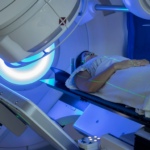
Prostate cancer is one of the most common cancers among men, and radiation therapy is a critical treatment option for managing this disease. Radiation therapy, also known as radiotherapy, uses high-energy rays or particles to destroy cancer cells. This blog will delve into the different types of radiation therapy, how they work, potential side effects, and what patients can expect during treatment. Understanding these aspects can help patients make informed decisions about their treatment options.
Types of Radiation Therapy
Radiation therapy for prostate cancer can be broadly categorized into two types: external beam radiation therapy (EBRT) and brachytherapy.
External Beam Radiation Therapy (EBRT)
External beam radiation therapy (EBRT) is frequently utilized as a radiation treatment option for prostate cancer. It involves directing high-energy x-rays from outside the body onto the prostate. The process is typically conducted over several weeks, with patients receiving treatment five days a week.
Types of EBRT:
- 3D Conformal Radiation Therapy (3D-CRT): This technique uses imaging technology to map the exact shape and size of the tumor, allowing precise targeting of the cancerous tissues while sparing surrounding healthy tissues.
- Intensity-Modulated Radiation Therapy (IMRT): It is a more sophisticated version of 3D-CRT, where the intensity of radiation beams is adjusted to conform to the shape of the tumor. This allows for even more precise targeting, reducing damage to nearby organs and minimizing side effects.
- Proton Beam Therapy: Proton therapy employs protons rather than x-rays for treatment. Protons can be controlled more precisely, making it possible to deliver higher doses of radiation to the prostate with less impact on surrounding tissues. However, this therapy is available only at specialized centers.
Brachytherapy
Brachytherapy, also known as internal radiation therapy, involves placing radioactive seeds or sources directly into or near the tumor. This method allows for high doses of radiation in a very localized area.
Types of Brachytherapy:
- Low-Dose Rate (LDR) Brachytherapy: This involves placing small radioactive seeds in the prostate, where they slowly release radiation over several months. The seeds remain in the prostate permanently, but the radiation diminishes over time.
- High-Dose Rate (HDR) Brachytherapy: In HDR brachytherapy, radioactive sources are temporarily placed in the prostate through catheters. These sources deliver a high dose of radiation over a few minutes and are then removed. This procedure might be repeated several times over a few days.
How Radiation Therapy Works
Radiation therapy works by damaging the DNA of cancer cells. Cancerous cells are typically more sensitive to radiation than normal cells because they divide at a faster rate. When the DNA of a cancer cell is damaged, it cannot repair itself and eventually dies. The dead cells are broken down and eliminated by the body.
Potential Side Effects
While radiation therapy is effective in treating prostate cancer, it can cause side effects. These side effects can vary depending on the type of radiation, the dose, and the individual’s health. Common side effects include:
- Urinary Problems: Radiation can irritate the bladder and urethra, leading to increased frequency of urination, urgency, and discomfort.
- Bowel Problems: Some patients may experience diarrhea, rectal bleeding, or discomfort due to radiation affecting the rectum.
- Erectile Dysfunction: Radiation can damage the nerves and blood vessels that control erections, leading to erectile dysfunction.
- Fatigue: Many patients report feeling very tired during and after radiation therapy. This fatigue may last for several weeks or months.
Preparing for Radiation Therapy
Preparation for radiation therapy involves several steps:
- Consultation and Planning: The process begins with a consultation with a radiation oncologist who will evaluate the patient’s medical history and discuss the best treatment options. A planning session, known as a simulation, is conducted to map out the exact area to be treated.
- Imaging: Imaging tests such as CT scans, MRIs, or PET scans are used to precisely locate the prostate and plan the radiation delivery.
- Marking the Treatment Area: Small marks may be made on the skin to guide the placement of radiation beams. In certain instances, small gold markers are inserted into the prostate to enhance precision.
What to Expect During Treatment
During each session of External Beam Radiation Therapy (EBRT), the patient reclines on a treatment table as a device known as a linear accelerator administers the radiation. The procedure is painless and usually takes only a few minutes, although setup time can take longer. For brachytherapy, patients may need to undergo anesthesia as the radioactive seeds or sources are placed.
Post-Treatment Care
After completing radiation therapy, patients will have regular follow-up appointments to monitor their progress. These appointments may include physical exams, blood tests to measure prostate-specific antigen (PSA) levels, and imaging tests to check for any signs of cancer recurrence.
Radiation therapy remains a cornerstone in the treatment of prostate cancer, offering a high success rate with manageable side effects. Advances in technology have made it possible to target cancer cells more precisely, improving outcomes and quality of life for patients. Understanding the different types of radiation therapy, their benefits, and potential side effects can help patients navigate their treatment journey with confidence.
Summary
Radiation therapy is a crucial treatment option for prostate cancer, involving either external beam radiation therapy (EBRT) or brachytherapy. Each method has its advantages and potential side effects, but both aim to effectively destroy cancer cells while minimizing damage to surrounding tissues. Patients should discuss their options with their oncologist to determine the best course of action.
For those seeking expert care in prostate cancer treatment, Dr. Jagdish Shinde, based in Pimpri Saudagar, Pune, is renowned for his expertise. At Cancer Care Pune, Dr. Shinde is recognized as one of the best oncologists in Pune, providing advanced and compassionate care to his patients.




